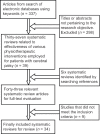Evidence-based Approach to Physical Therapy in Cerebral Palsy
- PMID: 30905979
- PMCID: PMC6394183
- DOI: 10.4103/ortho.IJOrtho_241_17
Evidence-based Approach to Physical Therapy in Cerebral Palsy
Abstract
Physiotherapy plays a key role in the management of cerebral palsy (CP) and comprises of various therapeutic interventions in enhancing the various physiological and functional outcomes. Though physiotherapy is used widely and recommended by all members of the health-care team, the effectiveness of physiotherapy is inconsistent. The objective of this review was to summarize and evaluate the effectiveness of physiotherapy interventions in children with CP. PubMed and Cochrane database were searched from January 2006 to April 2017 using the Medical Subject Heading and general keywords. Only systematic reviews and meta-analysis on PT interventions in children diagnosed with CP were included. Two reviewers independently assessed the methodological quality and retrieved the results. Thirty-four systematic reviews were identified that distinguished 15 different interventions. Moderate evidence of effectiveness was found for constraint-induced movement therapy for upper limb recovery, goal-directed/functional training, and gait training to improve gait speed. Conflicting evidence was found for the role of exercises on strength training and cardiorespiratory training. Intervention such as neurodevelopmental therapy (NDT) was found ineffective. This review suffer from limitations such as including reviews that had small sample size and that had considered heterogeneity of treatment interventions. Hence, the effectiveness of most PT interventions is found to be limited. On the basis of the present evidence, functional goal-oriented approaches are found to be effective and future research is required to determine the best ways to improve functional outcomes in children with CP.
Keywords: Cerebral palsy; exercise therapy; muscle weakness; physical activity; physical therapy techniques; rehabilitation.
Conflict of interest statement
There are no conflicts of interest.
References
-
- MedIndia Inc; c1997-2013. Medindia.net [homepage on the Internet]. Kathy Jones. Incidence of Cerebral Palsy Remains Constant in India on Indian Health News. [Last updated on 2010 Oct 04; Last accessed on 2013 Jan 22]. Available from: http://www.medindia.net/news/Incidence-of-Cerebral-Palsy-Remains-Constan... .
-
- Rosenbaum P, Paneth N, Leviton A, Goldstein M, Bax M, Damiano D, et al. A report: The definition and classification of cerebral palsy April 2006. Dev Med Child Neurol Suppl. 2007;109:8–14. - PubMed
-
- Shamir M, Dickstein R, Tirosh E. Intensive intermittent physical therapy in infants with cerebral palsy: A randomized controlled pilot study. Isr Med Assoc J. 2012;14:737–41. - PubMed
-
- Dodd KJ, Taylor NF, Damiano DL. A systematic review of the effectiveness of strength-training programs for people with cerebral palsy. Arch Phys Med Rehabil. 2002;83:1157–64. - PubMed
LinkOut - more resources
Full Text Sources
Medical
Miscellaneous

